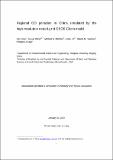| dc.contributor.author | Chen, Dan | |
| dc.contributor.author | Yuxuan, Wang | |
| dc.contributor.author | McElroy, Michael Brendon | |
| dc.contributor.author | He, Kebin | |
| dc.contributor.author | Yantosca, Robert M. | |
| dc.contributor.author | Le Sager, Philippe | |
| dc.date.accessioned | 2011-07-22T19:30:13Z | |
| dc.date.issued | 2009 | |
| dc.identifier.citation | Chen, Dan, Yuxuan Wang, Michael B. McElroy, Kebin He, Robert M. Yantosca, and Philippe Le Sager. 2009. Regional CO pollution in China simulated by the high-resolution nested-grid GEOS-Chem model. Atmospheric Chemistry and Physics Discussions 9: 5853-5887. | en_US |
| dc.identifier.issn | 1680-7367 | en_US |
| dc.identifier.uri | http://nrs.harvard.edu/urn-3:HUL.InstRepos:5029363 | |
| dc.description.abstract | An updated version of the nested-grid GEOS-Chem model is developed allowing for higher horizontal (0.5°×0.667°) and vertical resolution as compared to global models. CO transport over a heavily polluted region, the Beijing-Tianjin-Hebei (BTH) city cluster in China, and the pattern of outflow from East China in summertime are investigated. Comparison of the nested-grid with global models indicates that the fine-resolution nested-grid model is capable of resolving individual cities with high associated emission intensities. The nested-grid model indicates the presence of a high CO column density over the Sichuan Basin in summer, attributable to the low-level stationary vortex associated with the Basin's topographical features. The nested-grid model provides good agreement also with measurements from a suburban monitoring site in Beijing during summer 2005. Tagged CO simulation results suggest that regional emissions make significant contributions to elevated CO levels over Beijing on polluted days and that the southeastward moving cyclones bringing northwest winds to Beijing are the key meteorological mechanisms responsible for dispersion of pollution over Beijing in summer. Overall CO fluxes to the NW Pacific from Asia are found to decrease by a factor of 3–4 from spring to summer. Much of the seasonal change is driven by decreasing fluxes from India and Southeast Asia in summer, while fluxes from East China are only 30% lower in summer than in spring. Compared to spring, summertime outflow from Chinese source regions is strongest at higher latitudes (north of 35° N). The deeper convection in summer transporting CO to higher altitudes where export is more efficient is largely responsible for enhanced export in summer. | en_US |
| dc.description.sponsorship | Engineering and Applied Sciences | en_US |
| dc.language.iso | en_US | en_US |
| dc.publisher | Copernicus Publications | en_US |
| dc.relation.isversionof | http://www.atmos-chem-phys-discuss.net/9/5853/2009/ | en_US |
| dc.relation.hasversion | http://acmg.seas.harvard.edu/publications/danchen2009a.pdf | en_US |
| dash.license | OAP | |
| dc.title | Regional CO Pollution in China Simulated by the High-Resolution Nested-Grid GEOS-Chem Model | en_US |
| dc.type | Journal Article | en_US |
| dc.description.version | Accepted Manuscript | en_US |
| dc.relation.journal | Atmospheric Chemistry and Physics Discussions | en_US |
| dash.depositing.author | McElroy, Michael Brendon | |
| dc.date.available | 2011-07-22T19:30:13Z | |
| dc.identifier.doi | 10.5194/acp-9-3825-2009 | |
| dash.contributor.affiliated | Yantosca, Robert | |
| dash.contributor.affiliated | McElroy, Michael | |
| dash.contributor.affiliated | Le Sager, P | |


